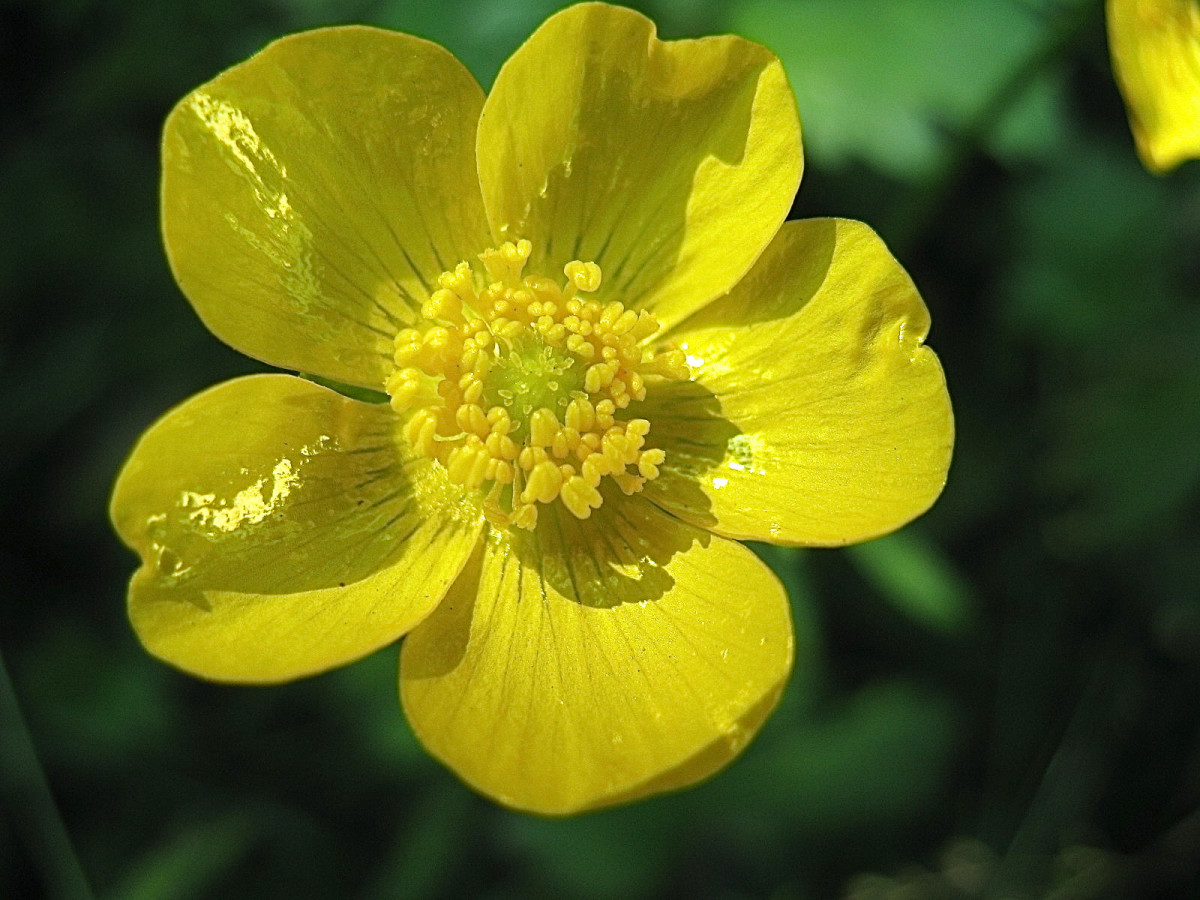Tall buttercup is a European species that has spread throughout North America, typically found in pastures and meadows and sometimes woodlands and coastal areas. Unlike the low-growing creeping buttercup, tall buttercup does not spread by stolons, just by seed, and is upright not creeping.
- Perennial Buttercup Plants
- Perennial Ranunculus Plant
- Yellow Buttercup Perennial Flowers
- Buttercup Perennial

Tall buttercup is not on the Washington State Noxious Weed List. However, in King County, Washington this non-native invasive buttercup species is classified as a Weed of Concern. For more information on noxious weed regulations and definitions, see Noxious weed lists and laws.
Identification
Tall buttercup is an upright, perennial broadleaf plant that grows from a cluster of fibrous roots. Stems are 1 to 3 feet tall, hairy, hollow, leafy below and branched above. Each root crown typically has several stems in a cluster. Flowers have 5 to 7 glossy yellow petals, are about 1 inch wide, and grow on long stalks.
Leaves at the base grow on long stalks and are divided deeply into 3 to 7 coarsely lobed segments that radiate from a common point like fingers on a hand. The upper leaves are smaller and have fewer lobes and teeth. Leaves are softly hairy. Seedlings have 2 egg-shaped cotyledons with 3 to 5 noticeable veins. Young plants form a rosette. The first true leaves are hairy, round to heart-shaped in general outline, and shallowly lobed and toothed. Leaves have long leaf stalks that are hairy except at the base.
Like Persian buttercup, creeping buttercup is a perennial, growing best in USDA zones 4 through 9. Because it's grown mainly as a ground cover, or to naturalize a large, wild area, there is no. Ranunculus buttercup plants produce cheery multi-petaled flowers. The almost unpronounceable name covers a large group of perennials from Asia and Europe. The plants aren’t very hardy and may be annual in colder zones. They are easily damaged by temperatures below 28 F. (-2 C), and thrive best in USDA zones 8 to 10. Prefers moist, compost-rich soil. Primula will tolerate morning sun with afternoon shade. Can be divided every 2 to 3 years right after bloom or in early fall. Be sure to replant so that the crown is just above soil surface.
Impacts
Tall buttercup can dominate a pasture or meadow given the opportunity, especially with acid soils and/or over-grazing. It could hinder colonization by native species in a prairie or grassland habitat if it were allowed to invade and spread.
The main impact is to livestock. Fresh buttercup plants are toxic to grazing animals, who can suffer from salivation, skin irritation, blisters, abdominal distress, inflammation, and diarrhea. Fortunately, buttercup has a strong, bitter taste so animals generally try to avoid it if more palatable forage is available. Also, the toxin protoanemonin is not very stable and loses its potency when dry, so buttercup is not generally toxic in hay. Unfortunately, livestock occasionally develop a taste for buttercup and consume fatal quantities. It is safest to keep populations of buttercup under control on grazed pastures and offer plenty of healthy forage.
Growth and reproduction
Tall buttercup spreads only by seed and is a short-lived perennial. It blooms from late May to September and is pollinated by a variety of insects. Seeds are dispersed by wind, birds, farm animals, small rodents, clothes and tires. Seed germination is usually in spring and generally requires open soil.
Tall buttercup can be found in a variety of habitats, including wet lowlands and rich woodlands and is a common weed in pastures, meadows, and along roadsides. It usually does not persist in cultivated fields. Tall buttercup prefers heavy, moist soils but can grow in sandy or gravelly soil is there is sufficient moisture available.
Control
Prevention and cultural control
- In lawns and pastures, promote healthy grass by overseeding, fertilizing as needed, and not over-grazing. Adding lime can improve grass health and keep buttercup from re-establishing. However, lime won’t control buttercup that is already well-established.
- It also helps to improve soil drainage. Reduce compaction by aerating and avoid trampling when soils are wet.
- Clean mowers and other equipment to avoid spreading buttercup seeds to un-infested areas.
Manual
- Pull or dig up plants, removing all of the roots. Digging is most effective in the spring and early summer while the soil is moist and roots won’t break off as much.
- Disturbance of the soil can increase seed germination.
Mechanical
- This weed will not survive cultivation so plowing a field or meadow will help control it.

Chemical
Perennial Buttercup Plants
- Herbicides can be used if allowed and appropriate for the site and land use. Follow all label directions to ensure safe and effective use.
- Broadleaf herbicides can be applied over grassy areas infested with creeping buttercup to selectively kill the buttercup and not the grass. Products containing the active ingredient MCPA are most effective on buttercup. Metsulfuron (Escort, Ally) is also effective but can harm some grasses. Follow label directions on timing and rates.
- Glyphosate (e.g. Roundup, Aquamaster) can be applied to actively growing plants before they seed. Keep spray off of grass and other plants. Re-seed or re-plant bare areas after removing buttercup to keep it from re-infesting the area.
- It will probably take at least two or three applications to eradicate tall buttercup because of the seed bank and because some mature plants will generally recover.
- Monitor the treated area for re-growth and pull up any new seedlings before they establish runners.
Perennial Ranunculus Plant

Additional information on tall buttercup (Ranunculus acris )
- Photos and Distribution from the University of Washington Burke Museum (external link)
- Alaska Natural Heritage Program (external link, pdf)
- Ohio Perennial and Biennial Weed Guide (external link)
- Photos of Tall Buttercup from Invasive.org (external link)
- Photos of Tall Buttercup from Forestry Images (external link)
Yellow Buttercup Perennial Flowers
What to do if you find this plant in King County, Washington

Because tall buttercup is so widespread, property owners in King County are not required to control it and we are not generally tracking infestations. We can provide advice on how to control tall buttercup, but there is generally no legal requirement to do so.
Ranunculaceae
Plants of the Buttercup Family
The Buttercup family is like a window back in time. None of today's species were around 100 million years ago, but the Buttercups and other primitive groups like the Magnolias have retained the most ancestral characteristics over time. The Buttercups are considered very 'simple' because the floral parts-the petals, sepals, stamens and pistils-are all of an indefinite number and separate from one another. Also, the stamens and pistils are spirally inserted in a cone-like receptacle, although it is often very small to see. More advanced plant families have reduced, more specific numbers of floral parts, and the parts are often fused together.
The Buttercup family may be considered 'simple' from an evolutionary standpoint, but it includes some flowers that are highly complex in appearance, such as the delphinium and columbine. Yet these flowers are still considered 'simple' because all the parts are independently attached.
You may discover that the most common pattern of the family is the apparent lack of a pattern! Buttercups can have either regular or irregular flowers with anywhere from 3 to 15 sepals, often colored like petals, and 0 to 23 actual petals. There are often, but not always, numerous stamens and 3- to numerous simple pistils (apocarpous). The floral parts are all independently attached below a superior ovary. Most have bisexual flowers, except some species of meadow rue (Thalictrum) and Clematis. Worldwide, there are 35-70 genera in the Buttercup family and about 2,000 species. Twenty-three genera are found in North America.
For the purposes of identification, the most accurate pattern to look for is the multiple simple pistils at the center of the flower. In more advanced plant families there is typically only one pistil, the result of a reduction in numbers along with the fusion of several pistils to make a single compound pistil. A flower with multiple pistils is very likely a Buttercup, but could potentially be confused with species from the Rose subfamily of the Rose Family. A secondary pattern that is often easier to see, but not as consistent, is the hooked tips on the pistils. If you are not sure if you are looking at several separate pistils or some that are only partially fused together, then look for a hook at the tip of the pistil. Many species have hooked pistils, and the hooks often persist as the ovary matures after pollination.
The predominant property in the plants of the Buttercup family is an acrid protoanemonin glycoside oil. Most of the species are listed as poisonous, but most are safe to taste. The buttercup taste is biting and acrid, stronger in some plants than others. Taste it and spit it out. The acrid properties of the buttercups are unstable and are destroyed by drying or cooking, so the very mild buttercups are edible as salad greens or pot herbs. But be careful not to over do even these, as the residual acrid properties may cause a mild inflammation of the kidneys or liver. Mucilaginous plants can be ingested to counter-effect the acrid buttercups. Medicinally, the acrid nature of the plants makes them great for stimulating poultices, similar to a 'mustard plaster'. These poultices can be used on bruises, aches or arthritis to stimulate healing activity inside, but be careful, because the poultices can cause blistering if left in place too long. The poultice can even stimulate activity in cases of mild paralysis. The acrid quality is also beneficial for getting rid of lice. Goldenseal (Hydrastis) is a popular medicinal herb from this family. It is favored for the very bitter and highly antiseptic berberine alkaloid, also found in a few related genera and in the Barberry Family.
WARNING: A number of plants in this family, especially Aconitum and Delphinium contain concentrations of toxic terpenoid alkaloids. These alkaloids depress the central nervous system; they are often used for nervous disorders, antispasmodics and sedatives. Some of these plants can be cautiously used internally (by professionals only!) as heart and respiratory sedatives.
Key Words:Dicot flowers with three or more simple pistils, often with hooked tips.
Buttercup Perennial
Please e-mail Thomas J. Elpel to report mistakes or to inquire about purchasing high resolution photos of these plants.

